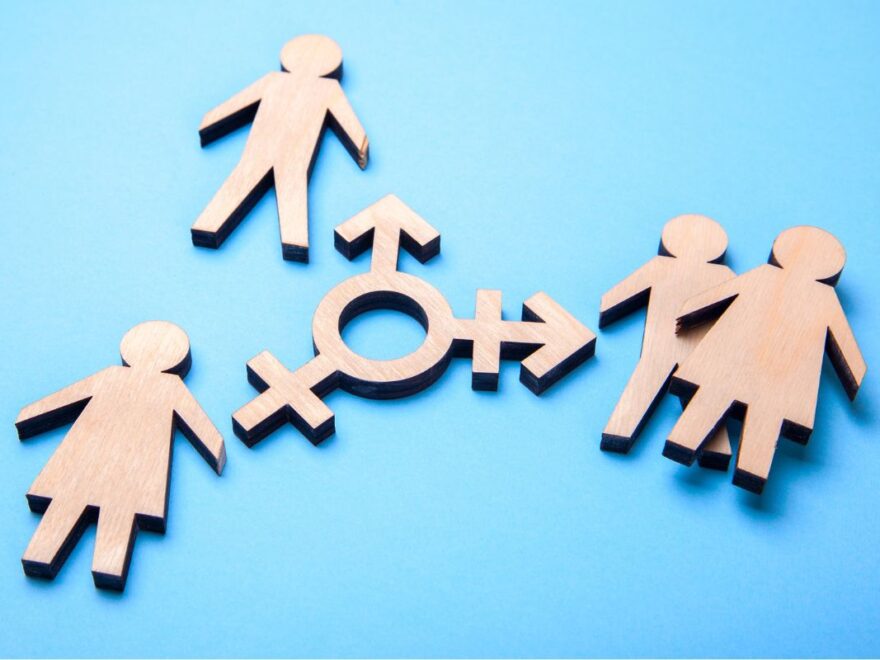Gender Dysphoria
Gender dysphoria is the feeling of discomfort or distress that may occur in people whose gender identity differs from their sex assigned at birth or sex-related physical characteristics.
Transgender and gender-diverse people might experience gender dysphoria at some point in their lives. However, some transgender and gender-diverse people feel at ease with their bodies, with or without medical intervention.

Symptoms of Gender Dysphoria
Gender dysphoria might cause youngsters and adults to experience a marked difference between inner gender identity and assigned gender that lasts for at least six months. The difference is shown by at least two of the following:
- A difference between gender identity and genitals or secondary sex characteristics, such as breast size, voice, and facial hair. In young individuals, there is a difference between gender identity and anticipated secondary sex characteristics.
- A strong desire to be rid of these genitals or secondary sex characteristics or a desire to prevent the development of secondary sex characteristics.
- A strong desire to have the genitals and secondary sex characteristics of another gender.
- A strong desire to be or to be treated as another gender.
- A strong belief in having the typical feelings and reactions of another gender.
Gender dysphoria may also cause significant distress that affects how you function in social situations, at work or school, and in other areas of life.
Gender dysphoria might start in childhood and continue into adolescence and adulthood. Or you might have periods in which you no longer experience gender dysphoria. You might also experience gender dysphoria around the time of puberty or much later in life.
Complications of Gender Dysphoria
Gender dysphoria can affect many aspects of life, including daily activities. People experiencing gender dysphoria might have difficulty in school due to pressure to dress in a way that’s associated with their sex assigned at birth or out of fear of being harassed or teased.
- If gender dysphoria impairs the ability to function at school or work, the result may be school dropout or unemployment.
- Relationship difficulties are common.
- Anxiety, depression, self-harm, eating disorders, substance misuse, and other problems can occur.
- People who have gender dysphoria also often experience discrimination, resulting in stress.
- Accessing health services and mental health services can be difficult due to fear of stigma and a lack of experienced care providers.
- Adolescents and adults with gender dysphoria without gender-affirming treatment might be at risk of thinking about or attempting suicide.
Diagnosis of Gender Dysphoria
Gender dysphoria is different from simply not conforming to stereotypical gender role behavior. It involves feelings of distress due to a strong, pervasive desire to be another gender.
Some adolescents might express their feelings of gender dysphoria to their parents or a doctor. Others might instead show symptoms of a mood disorder, anxiety, or depression. Or they might experience social or academic problems.
Treatment of Gender Dysphoria
Treatment can help people who have gender dysphoria explore their gender identity and find the gender role that feels comfortable for them, easing distress. However, treatment should be individualized. What might help one person might not help another.
Treatment options might include changes in gender expression and role, hormone therapy, surgery, and behavioral therapy.
If you have gender dysphoria, get help from a doctor who has expertise in the care of gender-diverse people.
When coming up with a treatment plan, your provider will screen you for mental health concerns that might need to be addressed, such as depression or anxiety. Failing to treat these concerns can make it more difficult to explore your gender identity and ease gender dysphoria.
Changes In Gender Expression And Role
This might involve living part-time or full-time in another gender role consistent with your gender identity.
Medical Treatment of Gender Dysphoria
Medical treatment of gender dysphoria might include:
- Hormone therapy, such as feminizing hormone therapy or masculinizing hormone therapy
- Surgery, such as feminizing surgery or masculinizing surgery to change the chest, external genitalia, internal genitalia, facial features, and body appearance.
Some people use hormone therapy to seek maximum feminization or masculinization. Others might find relief from gender dysphoria by using hormones to minimize secondary sex characteristics, such as breasts and facial hair.
Treatments are based on your goals and an evaluation of the risks and benefits of medication use. Treatments may also be based on any other conditions and consideration of your social and economic issues. Many people also find that surgery is necessary to relieve their gender dysphoria.
Additional criteria apply to some surgical procedures.
A pre-treatment medical evaluation is done by a doctor with experience and expertise in transgender care before hormonal and surgical treatment of gender dysphoria. This can help rule out or address medical conditions affecting these treatments. This evaluation may include:
- A personal and family medical history
- A physical exam
- Lab tests
- Assessment of the need for age- and sex-appropriate screenings
- Identification and management of tobacco use and drug and alcohol misuse
- Testing for HIV and other sexually transmitted infections, along with treatment, if necessary
- Assessment of desire for fertility preservation and referral as needed for sperm, egg, embryo, or ovarian tissue cryopreservation
- Documentation of the history of potentially harmful treatment approaches, such as unprescribed hormone use, industrial-strength silicone injections, or self-surgeries
Behavioral Health Treatment
This treatment aims to improve your psychological well-being, quality of life, and self-fulfillment. Behavioral therapy isn’t intended to alter your gender identity. Instead, therapy can help you explore gender concerns and find ways to lessen gender dysphoria.
The goal of behavioral health treatment is to help you feel comfortable with how you express your gender identity, enabling success in relationships, education, and work. Therapy can also address any other mental health concerns.
Therapy might include individual, couples, family, and group counseling to help you:
- Explore and integrate your gender identity
- Accept yourself
- Address the mental and emotional impacts of the stress that results from experiencing prejudice and discrimination because of your gender identity (minority stress)
- Build a support network.
- Develop a plan to address social and legal issues related to your transition and coming out to loved ones, friends, colleagues, and other close contacts.
- Become comfortable expressing your gender identity
- Explore healthy sexuality in the context of gender transition
- Make decisions about your medical treatment options
- Increase your well-being and quality of life
Therapy might be helpful during many stages of your life.
A behavioral health evaluation may not be required before receiving hormonal and surgical treatment for gender dysphoria, but it can play an important role when making decisions about treatment options. This evaluation might assess the following:
- Gender identity and dysphoria
- Impact of gender identity in work, school, home, and social environments, including issues related to discrimination, abuse, and minority stress
- Mood or other mental health concerns
- Risk-taking behaviors and self-harm
- Substance misuse
- Sexual health concerns
- Social support from family, friends, and peers — a protective factor against developing depression, suicidal thoughts, suicide attempts, anxiety, or high-risk behaviors
- Goals, risks, and expectations of treatment and trajectory of care
Other Steps
Other ways to ease gender dysphoria might include the use of:
- Peer support groups
- Voice and communication therapy to develop vocal characteristics matching your experienced or expressed gender
- Hair removal or transplantation
- Genital tucking
- Breast binding
- Breast padding
- Packing
- Aesthetic services, such as makeup application or wardrobe consultation
- Legal services, such as advanced directives, living wills, or legal documentation
- Social and community services to deal with workplace issues, minority stress, or parenting issues
Coping and Support
Gender dysphoria can be lessened by supportive environments and knowledge about treatment to reduce the difference between your inner gender identity and the sex assigned at birth.
Social support from family, friends, and peers can be a protective factor against developing depression, suicidal thoughts, suicide attempts, anxiety, or high-risk behaviors.
Other options for support include:
- Mental health care. You might see a mental health professional to explore your gender, talk about relationship issues, or talk about any anxiety or depression you’re experiencing.
- Support groups. Talking to other transgender or gender-diverse people can help you feel less alone. Some community or LGBTQ centers have support groups. Or you might look online.
- Prioritizing self-care. Get plenty of sleep. Eat well and exercise. Make time to relax and do the activities you enjoy.
- Meditation or prayer. You might find comfort and support in your spirituality or faith communities.
- Getting involved. Give back to your community by volunteering, including at LGBTQ organizations.
Sehatyab supports individuals experiencing gender dysphoria by connecting them with knowledgeable psychologists who specialize in gender identity issues. Through online sessions, therapists provide therapy sessions to individuals and help them explore their feelings and build self-acceptance. They also offer guidance on coping with societal pressures and emotional stress, assisting individuals to create a path toward improved mental well-being.
Preparing For Your Appointment
You may start by seeing your primary care provider. Or you may be referred to a behavioral health professional.
Here’s some information to help you get ready for your appointment.
What You Can Do!
Before your appointment, make a list of:
- Your symptoms, including any that seem unrelated to the reason for your appointment
- Key personal information, including significant stresses, recent life changes, and family medical history
- All medications, vitamins, or other supplements you take, including the doses
- Questions to ask your healthcare provider
Sehatyab connects mental health patients with psychologists and psychiatrists, offering a holistic approach to treatment. Whether it’s therapy for emotional challenges or medical support for mental health conditions, Sehatyab provides easy access to expert professionals who offer extensive treatment plans. The platform ensures privacy, accessibility, and expert guidance, making quality mental health care available to everyone.
Our Doctors for Gender Dysphoria
Dr. Syed Masroor Ali
Psychiatrist
MBBS, MCPS, Certified RANZCP Forensic Psychiatry (The Royal Australian and New Zealand College of Psychiatrists)
Experience: 35+ years
Mr. Hayat Ali Yousefzai
Clinical Psychologist
ECPS (ISSM), CHPE (JSMU), SRHR (Geneva Foundation), MS Psychology, PhD Clinical Psychology (Continue), Member of American Psychological Association (APA), Member of International Society for Sexual Medicine, Member of Pakistan Psychological Association
Experience: 10+ years
Dr. Ali Ajmal
Clinical Psychologist
MSc, M.Phil. Applied Psychology (Punjab), PhD (Clinical Psychology), Advanced diploma in clinical psychology (ADCP)
Experience: 11+ years
Ms. Maryam Khan
Clinical Psychologist
BSc (Psychology), MSc (Psychology) – QAU Islamabad, PGDCP (Clinical Psychology), Certified: Hypnotherapist (NGH, USA), Play Therapist, Psycho-sexual Disorder Therapist, Cognitive-behavioral Therapist
Experience: 8+ years
Our blogs on Gender Dysphoria

Anxiety Attack and Panic Attack: The Difference

جینڈر ڈسفوریا کیا ہے، علامات و علاج





